The Story of Sasando The Bamboo Harp from Indonesia
Sasando the bamboo harp from Indonesia, is one of the most unique instruments you’ll ever see or hear. While most of us know what a guitar or a piano looks like, the Sasando is something else entirely.
It comes from Rote Island in Indonesia, and it’s a brilliant example of how people can use nature to create beautiful music. This special type of bamboo tube zither blends a simple bamboo body with fanned palm leaves to make a sound that feels both magical and real.
This article will be your guide to this amazing instrument. We’ll explore its cool origin story, see how it’s made, understand its special sound, and follow its journey into the world of modern music.
Let’s get to know the instrument that truly captures the sound of its island home.
What is the Origin Story of the Sasando?
The story of the Sasando begins on Rote Island, part of the East Nusa Tenggara province of Indonesia. This is where the instrument was born and became a key part of the local indigenous music.
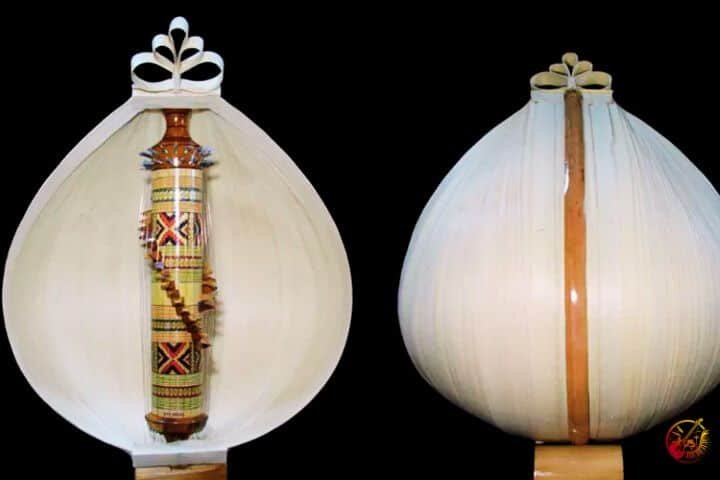
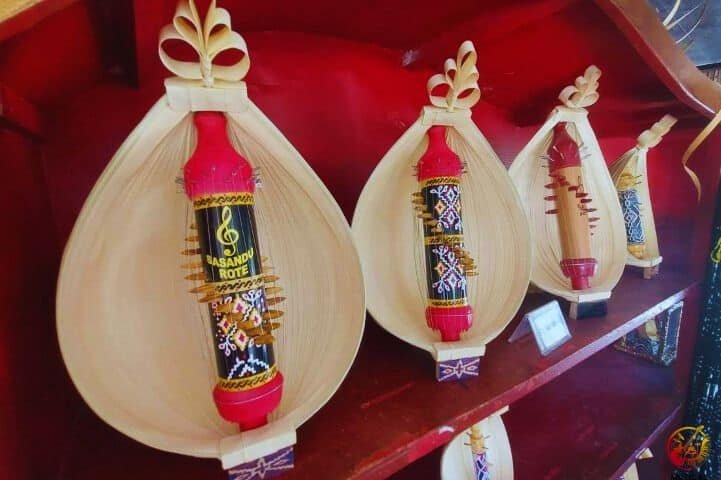
Even its name tells you exactly what it does. It comes from the Rote dialect word “sasandu,” which simply means “to vibrate” or “a sounding thing.”
But the story of how it was created is much more poetic. A popular local legend tells of a young man named Sangguana. After his boat wrecked, he washed up on Rote Island. The local king liked him and said he could marry his daughter, but only if he created a brand-new musical instrument.
One night, while worrying about this challenge, Sangguana fell asleep under a lontar palm tree. He dreamed of a spider’s web stretched between the leaves. The dew drops on the web shined in the moonlight, and when the wind blew, they made a beautiful sound.
Waking up, Sangguana felt inspired. He built an instrument that looked just like the web in his dream, with strings going out from the middle.
This story is a great way to understand the instrument’s design. The Sasando has a bamboo center with strings that stretch over it, all held inside a fan of palm leaves.
For centuries, it was the main sound of Rote Island, played at harvest festivals, traditional ceremonies, and other important events.
How is a Traditional Sasando the Bamboo harp from Indonesia, Actually Made?
Making a Sasando is all about working with nature. It’s a perfect showcase of true musical craftsmanship. The builders are true artists who know exactly which materials to use. The whole handcrafted instrument is like a small team where the bamboo, wood, and palm leaves all work together perfectly.
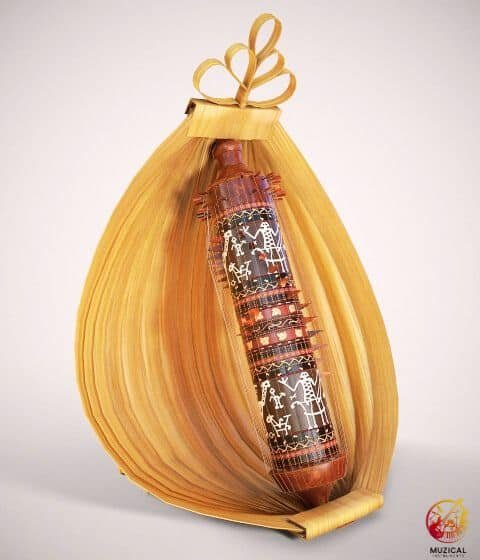
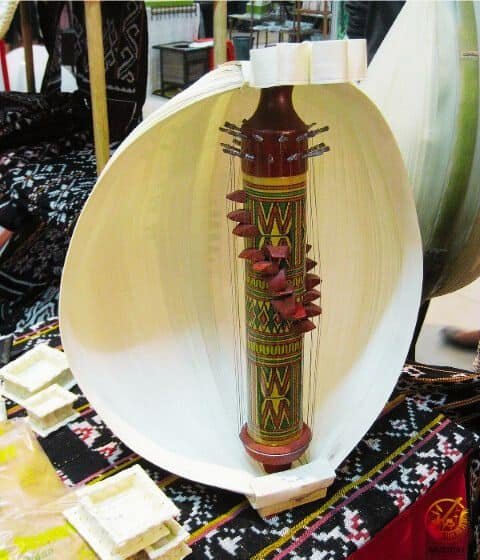
So, what is it made of? The main part, or soundbox, is a hollow tube of bamboo that has been dried for at least a year to make it strong. The strings run up and down along the outside of this tube.
Long ago, the strings were carefully peeled from the bamboo’s own skin. Today, builders use steel strings because they last longer and have a brighter sound.
The really clever parts are the tuning system and the resonator. To tune a Sasando, you don’t turn knobs. Instead, the musician slides small wooden wedges, called senda, under each string. Pushing a wedge up tightens the string and makes the note higher. Pushing it down loosens it and makes the note lower. It’s a simple but very smart design.
Then you have the part that everyone notices: the big, fan-like resonator. It’s made from dried lontar palm leaves, called hau, that are folded and arranged in a half-circle. This isn’t just for looks. The hau catches the sound from the strings and the bamboo, making it much louder. It works like a natural speaker for this unique stringed instrument.
| Component | Material | What It Does |
|---|---|---|
| Body (Soundbox) | Dried Bamboo Tube | The main frame that helps the sound ring out. |
| Strings | Steel (today) | Vibrate when plucked to make the musical notes. |
| Tuners | Wooden Wedges (Senda) | Slide to change the string tension and tune the pitch. |
| Resonator | Lontar Palm Leaves (Hau) | Acts like a natural amplifier to make the sound louder. |
What Makes the Sound of the Sasando So Unique?
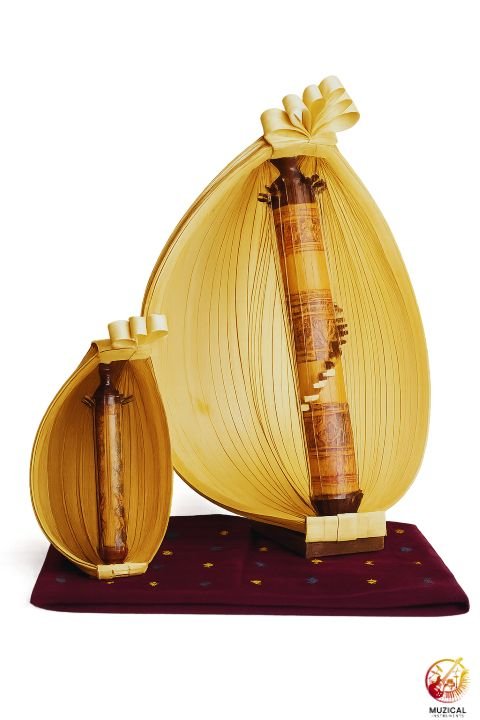
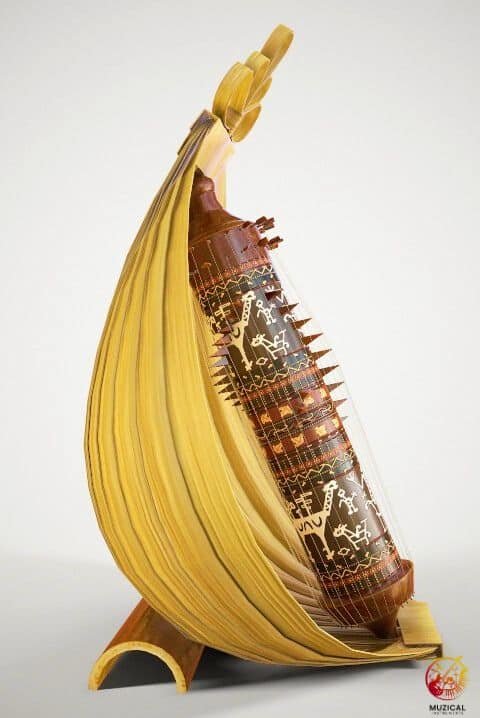
The sound of Sasando the bamboo harp from Indonesia, is often called heavenly. As a plucked instrument, it works when a musician pulls on the strings, but how it creates that special sound is a mix of its parts and playing style.
When a string is plucked, you hear a clear, harp-like note. But that sound also vibrates through the bamboo tube, which adds a warm, woody feeling to the music.
You can think of it this way: the string makes the voice, but the bamboo tube is like the chest that gives the voice its deep, full sound. That sound then hits the big palm leaf fan. The fan catches the sound waves and pushes them forward, making the instrument surprisingly loud.
So, you end up with a sound that has many layers: the sharp pluck of the string, the warm hum of the bamboo, and the wide, airy sound from the palm leaves.
How it’s played is also very important. The musician holds the instrument close to their body and uses the fingers of both hands to pluck the strings. This means they can play a bass line or chords with one hand and the main melody with the other. This technique lets players create rich, full music that makes Sasando the bamboo harp from Indonesia, so special.
Are There Different Kinds of the Sasando?
Yes, the instrument has changed over the years as music has changed. Today, you can find two main types of the Sasando: the classic acoustic ones and the new electric ones. They share the same basic design but are used for different kinds of music.
The traditional acoustic instruments are often grouped by their tuning. The oldest type is the Sasando Gong. It has around 7 to 11 strings and is tuned to a pentatonic scale (a five-note scale), which is common in traditional music. It’s used for ancient songs and dances.
Later, as Western music came to the area, a new version called the Sasando Biola was created. “Biola” is Indonesian for violin. This type has many more strings, often 32 or 36 and is tuned to the diatonic scale (the seven-note “do-re-mi” scale), letting it play modern pop and classical songs.
The biggest change was the creation of the Electric Sasando. Musicians who wanted to play in modern bands needed to be louder. So, they took off the palm leaf resonator and added electronic pickups. These pickups turn the string vibrations into a signal that can be plugged into an amplifier. This allows players to join rock or jazz bands and be heard on big stages, showing Sasando the bamboo harp from Indonesia, is a living one that continues to grow.
Who Are the Key People Keeping the Sasando Alive?
Sasando the bamboo harp from Indonesia, is known around the world today thanks to some very dedicated people. The most famous modern player is undoubtedly Djitron Pah. He took the Electric Sasando and showed it to the world, playing at music festivals everywhere. He mixes old melodies with new styles like jazz, showing just how much the instrument can do.
There are also traditional masters, like the late Buni Yani, who keep the old ways alive. They are heroes for saving the instrument’s original cultural heritage. And we can’t forget the builders.
In villages on Rote Island and in the nearby city of Kupang, families pass down the secrets of making a Sasando. Their work is studied by people in ethnomusicology, the study of music from different cultures.
Even the Indonesian government is helping. They are working to get Sasando the bamboo harp from Indonesia, listed by UNESCO as an important piece of world culture.
All these people, the players, the builders, and the supporters are part of the team keeping the music of the Sasando playing.
How Can You Experience or Even Learn the Sasando?
After learning about it, you might want to hear it or even try playing it. Luckily, it’s easier than ever. The best place to start is by listening online. Search for “Djitron Pah” on YouTube or a music app to hear the modern electric sound. For a more traditional vibe, search for “Sasando Rote” or “Sasando Gong.”
Is it hard to play? Like any stringed instrument, it takes practice. The trickiest part for new players is learning to pluck different strings with both hands at the same time. But with patience, anyone can learn to make a beautiful sound.
If you want to buy a Sasando the bamboo harp from Indonesia, the price can vary a lot. A small, simple one for a souvenir might be affordable. But a professional, handcrafted instrument made by a master artisan in Indonesia will cost much more because of the skill and time involved. Your best bet is to look for sellers online who specialize in world instruments. A trip to Rote Island or Kupang would be the ultimate way to experience it firsthand.
Final Thoughts: Why You Should Care About Sasando the bamboo Harp from Indonesia
Sasando the bamboo harp from Indonesia, is more than just a cool-looking instrument. It’s a beautiful reminder of how people and nature can work together to create art.
From its legendary start in a dream to its place on modern concert stages, the Sasando tells a story of change and strength. Its smart design, using simple bamboo and leaves to make such a rich sound, is truly inspiring.
The journey of this instrument shows that old traditions can find new life without losing what made them special in the first place.
So, here’s an easy next step for you. Find a quiet moment, go online, and search for a recording of a Sasando. Just close your eyes and listen. Let its unique sound take you to its island home.
When we listen to and share instruments like Sasando the bamboo harp from Indonesia, we do more than just save a sound. We celebrate the amazing stories and clever people from all over the world.
Frequently Asked Questions (FAQ)
1. What exactly is a Sasando?
The Sasando is a traditional stringed instrument that comes from Rote Island in Indonesia. It’s often called a bamboo harp because it has a central bamboo tube with strings stretched around it. It is famous for its beautiful, harp-like sound which is created using natural materials.
2. What is the Sasando made from?
A traditional Sasando the bamboo harp from Indonesia, is made entirely from local, natural materials. Its body is a hardened bamboo tube, the strings were historically made from the bamboo’s skin (but are now mostly steel), and its large, fan-like amplifier, called a resonator, is made from dried lontar palm leaves.
3. How does a Sasando produce its unique sound?
When a musician plucks the strings, the sound vibrates through the bamboo tube, which gives it a warm and woody tone. The large palm leaf fan then catches these vibrations and projects the sound outwards, which makes it louder and gives the music a unique, airy quality. It works like a built-in, natural speaker.
4. Is it difficult to learn how to play the Sasando?
Like any new instrument, playing the Sasando takes practice. The most challenging part for beginners is usually learning to use both hands to pluck different strings at the same time to create both melody and harmony. However, with patience, it is a very rewarding instrument to learn.
5. How much does a Sasando cost?
The price for a Sasando the bamboo harp from Indonesia, can vary widely. Small, decorative versions made for tourists can be quite affordable. However, a full-sized, professional, handcrafted instrument from a skilled artisan in Indonesia will cost significantly more, which reflects the expert craftsmanship and time needed to build one.
6. What’s the difference between an acoustic and an electric Sasando?
An acoustic Sasando uses its large fan of palm leaves to naturally amplify its sound, giving it that classic, organic tone. An electric Sasando, on the other hand, replaces the leaves with electronic pickups, similar to an electric guitar. This allows it to be plugged into an amplifier to be played much louder, making it perfect for modern bands and big concerts.
